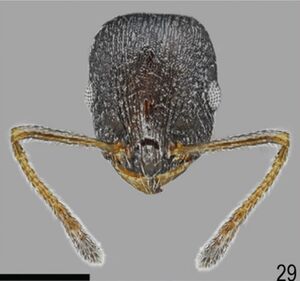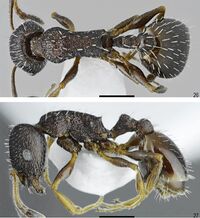Temnothorax ikarosi
| Temnothorax ikarosi | |
|---|---|

| |
| Scientific classification | |
| Kingdom: | Animalia |
| Phylum: | Arthropoda |
| Class: | Insecta |
| Order: | Hymenoptera |
| Family: | Formicidae |
| Subfamily: | Myrmicinae |
| Tribe: | Crematogastrini |
| Genus: | Temnothorax |
| Species group: | anodontoides |
| Species: | T. ikarosi |
| Binomial name | |
| Temnothorax ikarosi Salata, Borowiec & Trichas, 2018 | |
The biology of this species is poorly known. A single worker was collected on a wall of a shelter, the wall of which was overgrown by a blackberry bush. The shelter was found at the edge of an orchard on a mountain plateau (1750 m a.s.l.).
Identification
Salata et al. (2018) - Temnothorax ikarosi differs from most of Cretan species in uniform, dark body colouration and presence of thick, longitudinal striation on the whole head surface. On Crete it can be confused with Temnothorax daidalosi from which it differs in short, triangular propodeal spines and striation on head. Beyond Crete it is most similar to, but differs by: Temnothorax anodontoides, differing in the presence of propodeal spines and thicker head striation; Temnothorax dessyi, differing in low and convex petiole node, short propodeal spines and presence of dense, longitudinal striation on genae and lateral surfaces of mesosoma; Temnothorax rottenbergii, Temnothorax angustulus, Temnothorax mirabilis and Temnothorax niger, differing in thicker striation on head, lack of smooth surface between striation and short, triangular propodeal spines; Temnothorax sardous, differing in short, triangular propodeal spines and lack of dense/ heavy reticulation on petiole and postpetiole.
Keys including this Species
Distribution
Distribution based on Regional Taxon Lists
Palaearctic Region: Greece (type locality).
Distribution based on AntMaps
Distribution based on AntWeb specimens
Check data from AntWeb
Countries Occupied
| Number of countries occupied by this species based on AntWiki Regional Taxon Lists. In general, fewer countries occupied indicates a narrower range, while more countries indicates a more widespread species. |

|
Estimated Abundance
| Relative abundance based on number of AntMaps records per species (this species within the purple bar). Fewer records (to the left) indicates a less abundant/encountered species while more records (to the right) indicates more abundant/encountered species. |

|
Biology
Castes
Worker

| |
| . | |
Nomenclature
The following information is derived from Barry Bolton's Online Catalogue of the Ants of the World.
- ikarosi. Temnothorax ikarosi Salata, Borowiec & Trichas, 2018: 781, figs. 26-30 (w.) GREECE (Crete).
Unless otherwise noted the text for the remainder of this section is reported from the publication that includes the original description.
Description
Worker
(n=1): HL: 0.892; HW: 0.719; SL: 0.633; EL: 0.173; EW: 0.129; ML: 1.014; PSL: 0.162; SDL: 0.14; PL: 0.403; PPL: 0.23; PH: 0.273; PPH: 0.276; HTL: 0.59; PNW: 0.518; PW: 0.209; PPW: 0.281; HI: 80.6; SI1: 71.0; SI2: 88.0; MI: 58.2; EI1: 75.0; EI2: 14.5; TI: 122.0; PI: 147.4; PPI: 83.3.
Head, mesosoma, and gaster uniformly dark brown. Femora dark orange with dark brown central area. Tibiae and tarsus dark orange. Scape dark brown with dark orange apex. Antennae dark orange with darker, brown clubs.
Head quadrate, 1.2 times as long as wide, lateral surfaces below and above eyes straight, posterior edges gently convex, occipital margin of head straight or slightly arched. Anterior margin of the clypeus slightly convex. Eyes small, oval, 1.4 times as long as wide. Antennal scape short, in lateral view slightly curved, 0.7 times as long as length of the head, in apex gradually widened, its base with small, triangular tooth, funiculus long, club 3 segmented. Surface of scape with very fine microreticulation, shiny, covered with thin, dense, adpressed setae. Mandi bles rounded with thick sparse, longitudinal striae, shiny. Clypeus shiny with thick, longitudinal striae, area between striae smooth and shiny. Frontal carinae short, not extending beyond frontal lobes. Antennal fossa deep, with dense, thick roundly curved striae, area between striae with dense rugosity, shiny. Frontal lobes narrow, smooth with slight, dense longitudinal reticulation. Head covered on the whole surface with thick, dense longitudinal striation, area between striation with dense rugosity, matt. Sometimes genae with striation partly replaced by rugae, also with a few longitudinal striae. Entire head bearing suberect to erect, pale, short and thick setae.
Mesosoma elongate, 2.0 times as long as wide, slightly arched in profile. Pronotum convex on sides. Propodeal spines short, triangular, with wide base, directed upward, with acute tips. Dorsal surfaces of mesonotum and pronotum shiny, with thick, dense longitudinal rugae and striation, area between sculpture smooth and shiny. Dorsal surface of propodeum shiny, with dense reticulation and, sometimes, a few longitudinal wrinkles. Lateral surfaces of pronotum shiny, with sparse, thick longitudinal striation, area between striation rugae. Lateral surfaces of mesonotum and propodeum shiny, with thick and dense rugosity. Entire mesosoma bearing suberect to erect, pale, short and thick setae.
Petiole, in lateral view, with short peduncle, node high, with anterior and posterior faces straight, its dorsal surface flat, inclined downward. Postpetiole, in lateral view, regularly convex, apical half with gently convex sides. Peduncle and petiolar node and postpetiole dorsum shiny, with thick, dense reticulation, area between rugae smooth. Petiole and postpetiole on dorsal surfaces bearing sparse, short, semierect to erect setae.
Gaster smooth and shiny, bearing erect, thin, pale setae. Legs short, shiny, with fine microreticulation. Tibiae 0.7 times as long as head length, bearing adpressed setae on the whole surface. Inner margins of tibia with a row of erect setae.
Type Material
Holotype (w.) (CAS ENT0845912): GREECE, Crete, Lasithi Prov. Limnakarou Plateau 1750 m 35°06’N 25°28’E, 5.8.2000. M. Chatzaki (Museum of Natural History).
Etymology
Name refers to Greek hero Icarus (Ἴκαρος, /Ikaros/), who died during his escape from Crete.
References
- Salata, S., Borowiec, L. 2022. A review of the Temnothorax anodontoides species-group (Hymenoptera, Formicidae) from Greece. ZooKeys 1091: 139-159 (doi:10.3897/zookeys.1091.79085).
- Salata, S., Borowiec, L., Trichas, A. 2018. Taxonomic revision of the Cretan fauna of the genus Temnothorax Mayr, 1861 (Hymenoptera: Formicidae), with notes on the endemism of ant fauna of Crete. Annales Zoologici (Warsaw) 68(4): 769-808 (DOI 10.3161/00034541ANZ2018.68.4.004).
- Salata, S., Borowiec, L., Trichas, A. 2020. Review of ants (Hymenoptera: Formicidae) of Crete, with keys to species determination and zoogeographical remarks. Monographs of the Upper Silesian Museum No 12: 5–296 (doi:10.5281/ZENODO.3738001).
References based on Global Ant Biodiversity Informatics
- Salata S., L. Borowiec, and A.Trichas. 2018. Taxonomic Revision of the Cretan Fauna of the Genus Temnothorax Mayr, 1861 (Hymenoptera: Formicidae), with Notes on the Endemism of Ant Fauna of Crete. Annales Zoologici (Warsaw) 68(4): 769-808.
- Salata S., and L. Borowiec. 2018. Taxonomic and faunistic notes on Greek ants (Hymenoptera: Formicidae). Annals of the Upper Silesian Museum in Bytom Entomology 27: 1-51.
